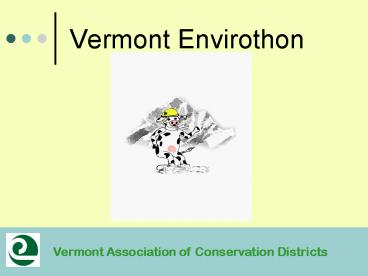Vermont Envirothon - PowerPoint PPT Presentation
1 / 34
Title: Vermont Envirothon
1
Vermont Envirothon
Vermont Association of Conservation Districts
2
Hands-on Natural Resource Education for Vermont
High School-aged Students.
3
Coordinated by
- Vermont Association of Conservation Districts
- A non-profit organization representing VTs 14
Natural Resource Conservation Districts Contact
Carrie Riker 802-888-9218 ext. 17 - www.vacd.org
Supported nationally by
4
(No Transcript)
5
What is the Vermont Envirothon?
- A competition that
- challenges high school students knowledge of the
environment. - provides students with the knowledge, skills, and
willingness to participate in natural resource
problem solving. - emphasizes teamwork, critical thinking skills,
and creative investigation. - combines in-class curriculum with field
experiences.
6
The Vermont Envirothon
- Each of the Envirothons five topic areas
contains a variety of activities and content that
can be identified as being addressed in the
Vermont Framework of Standards and Learning
Opportunities. - For each of the Key Points, the applicable
Vermont standard is identified by the standard
number.
7
Who Can Enter the Envirothon?
- High schools, home-schooled groups, youth groups,
and church youth groups can form an Envirothon
team. - Each group is comprised of 5 high-school aged
students, one or more alternates and a coach. - The coach can be a teacher, administrator,
parent, or youth leader.
8
How does the Envirothon Work?
- Throughout the school year, Envirothon teams
study natural resource concepts. - Teams work with natural resource professionals
gaining field experience. - In the spring, each team competes in a state-wide
Envirothon. - The winning team represents Vermont at the
International Envirothon during the summer.
9
(No Transcript)
10
What do students learn?
- Four natural resource components
- Soils
- Forestry
- Wildlife
- Aquatic ecosystems
- An environmental issue in depth
- Past examples Wetlands, non-point source
pollution, invasive species, pesticides, water
stewardship in a changing climate, etc.
11
Soils
- Basic soil structure
- Physical, chemical, and biological properties
- Soils role in the environment
- Soil erosion, non-point source pollution, global
warming - Soils influence on land use
- Development, agricultural, wetland, and
recreational uses
12
Students learning soil structure from NRCS Soil
Scientist, Thom Villars.
13
Becoming familiar with the local USDA Natural
Resource Conservation Service Soil Survey is part
of on-the-ground experiences.
14
Forestry
- Tree identification
- Basic tree structure and function
- Forest Ecology
- Fragmentation, biodiversity, forest health
- Forest Management
- Even-aged vs. Uneven-aged Management, Accepted
Management Practices (AMPs) - Wildlife Habitat
- Species requirements for food, shelter, and range
15
Forestry is an important natural resource concept
students study in depth.
16
Local and Vermont tree identification is an
important part of Forestry.
17
Hands-on problem solving is part of the final
Envirothon Competition
18
Wildlife
- Common species identification
- Natural history, basic needs, role in the
ecosystem - Habitat requirements
- Limiting factors, enhancing habitat,
predator/prey relationships - Human interaction
- Hunting, invasive species, rabies, West Nile
virus
19
Students learn to identify many species of
mammals, birds, and insects. They also study
habitat needs and where animals fit into the
bigger ecosystem.
20
Is it an owl? If so, what kind of owl. Can
students identify the kind of owl by its who
who, who whoooooo?
21
Aquatics
- Common freshwater species identification
- Fish, insects, plants, amphibians
- Water Resources
- Groundwater, surface water, rivers, lakes,
wetlands - Threats to Aquatic Resources
- Pollution, invasive species, competing uses,
mitigation of damage
22
What aquatic species can be found in water
samples from an area lake or stream?
23
What does this tiny insect indicate about the
quality of the water? Why is it important?
24
Current Environmental Issue
A special topic assigned each year by the
National Envirothon Competition provides a
hands-on challenge
- Solve a current problem in the teams local
environment - Identify, investigate, brainstorm solutions,
create recommendations - Create a public presentation addressing the issue
- Present to a panel of judges at the state
competition
25
Students work as a team to prepare a presentation
about a challenging local environmental problem.
26
The presentation must use creative visual aids to
communicate a solution and display teamwork.
27
This local high school studied their watershed
for non-point source pollution.
28
What additional skills do students gain?
- use reasoning strategies, knowledge, and common
sense to solve environmental problems. - use scientific methods to describe, investigate,
and explain natural phenomena. - interact with natural resource professionals from
several disciplines.
29
In addition to learning about natural resource
concepts, students also acquire skills in problem
solving, decision making, teamwork, and
communications.
30
Timeline of Activities
- September March Envirothon teams register and
receive study aids. - September May Envirothon teams work with local
Conservation Districts and natural resource
professionals who provide hands-on training. - February-March Problem solving exercise on the
current issue is sent to teams. - April Day-long training held.
- May Envirothon Competition held.
31
Past Envirothon Winners!
32
Envirothon Participation
- Over 800 Vermont students have participated since
1996. - New schools, home-school groups, and youth groups
such as 4-H, scouts, and church groups are
welcome and encouraged to join.
33
How Do I Get Involved?
- Become a team coach or co-coach
- Get a team of 5-8 high school aged students
together and register
34
Please join us in bringing the Envirothon to
Vermonts students.
www.vacd.org
Vermont Association of Conservation Districts































